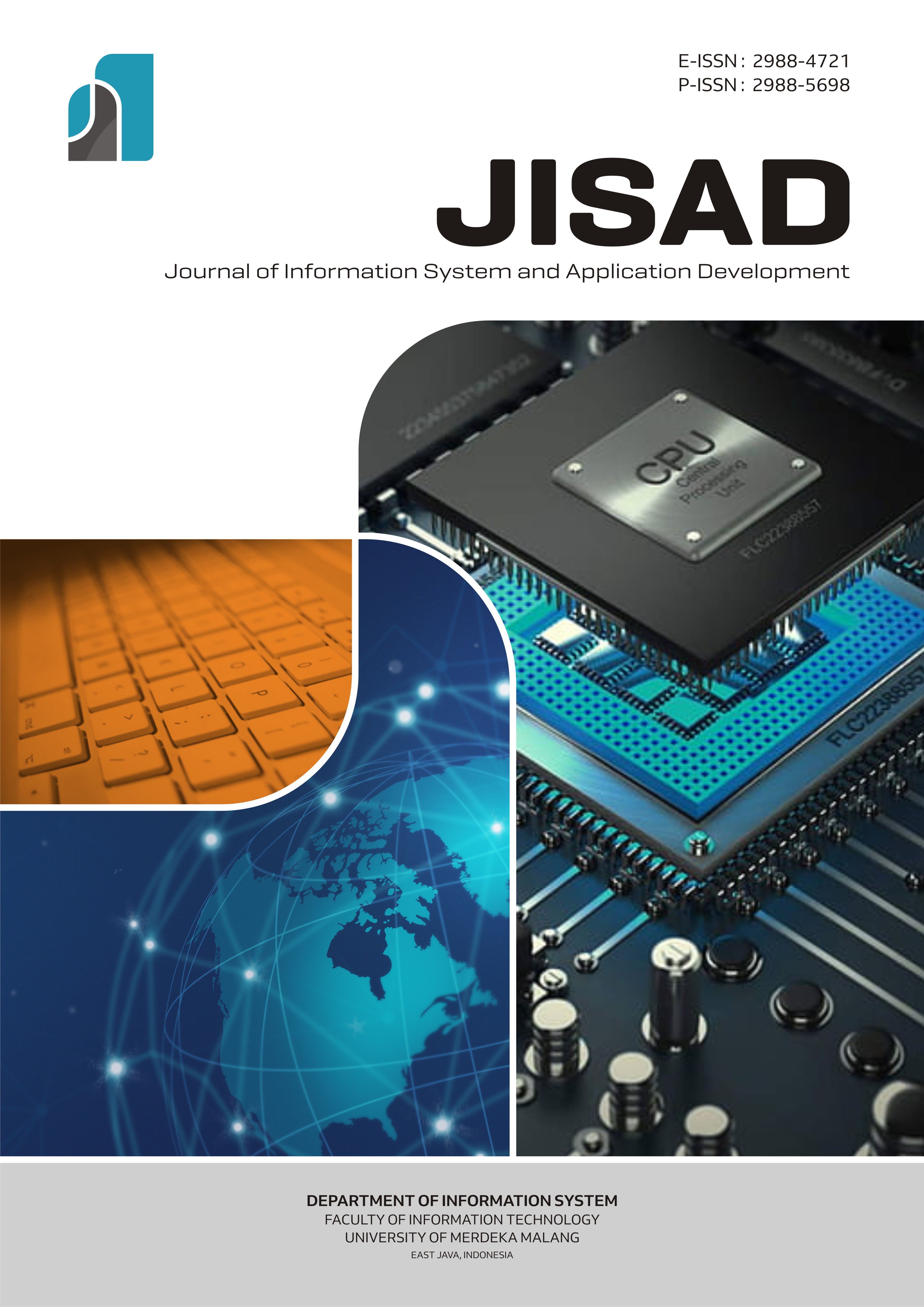Analisis komparatif metode dekomposisi aditif dan multiplikatif dalam memprediksi penjualan pada industri fashion
DOI:
https://doi.org/10.26905/jisad.v3i1.15395Keywords:
sales forecasting, additive decomposition, multiplicative decomposition, trend patternAbstract
Sales forecasting is very important, especially for businesses engaged in the fashion sector to make strategic decisions. This study aims to compare the additive and multiplicative decomposition methods in forecasting the sales of couple prayer mats at Elora Fashion. The dataset used consists of monthly sales data from January 2021 to September 2024. Through decomposition methods, the analysis was conducted to observe changes in trends, seasonal components, cycles, and random variations. The trend analysis indicated a rising sales pattern. The highest seasonal index occurred in June, while the lowest was in February. The sales forecast for the period from October to December 2024 predicts an increase in October and December, with a decline in November. The results show that decomposition methods are effective in identifying trend and seasonal patterns, which can support inventory optimization and marketing strategies. The comparative study between the Additive and Multiplicative Decomposition methods did not show significant differences. However, the Additive Decomposition method was considered superior due to its lower MAPE value.
Downloads
References
[1] C. P. Pratiwi et al., “The Rise of Digital Marketing Agencies: Transforming Digital Business Trends,” J. Apl. Bisnis dan Manaj., vol. 10, no. 1, pp. 162–172, 2024, doi: 10.17358/jabm.10.1.162.
[2] V. B. Tarigan and N. Nurhayati, “Penerapan Anggaran Penjualan dalam Memperkirakan Penjualan,” J. Bus. Econ. Res., vol. 3, no. 3, pp. 399–407, 2022, doi: 10.47065/jbe.v3i3.2394.
[3] A. Puspitaningtyas and M. Abdulrahim, “Penerapan Metode Peramalan Sebagai Upaya Mengurangi Bullwhip Effect Pada UMKM Pentol X,” J. Ilm. Tek. dan Manaj. Ind., vol. 3, no. 1, pp. 761–766, 2023.
[4] A. Setiawan, R. Filia Sari, and R. Aprilia, “Peramalan Hasil Panen Kelapa Sawit di PTPN IV Unit Berangir dengan Metode Dekomposisi (Ilmu Matematika),” J. Pembelajaran Dan Mat. Sigma, vol. 10, no. 1, pp. 82–92, 2024, doi: 10.36987/jpms.v10i1.5557.
[5] K. A. Rijal, A. V. Vitianingsih, Y. Kristyawan, A. L. Maukar, and S. F. A. Wati, “Forecasting Model of Indonesia’s Oil & Gas and Non-Oil & Gas Export Value using Var and LSTM Methods,” J. Teknol. dan Manaj. Inform., vol. 10, no. 1, pp. 59–69, 2024, doi: 10.26905/jtmi.v10i1.13127.
[6] A. Anwar and N. L. S. Supartiningsih, “Peramalan Penjualan Buah Impor Di Arena Buah Kecamatan Cakranegara,” J. Agrimansion, vol. 24, no. 2, pp. 372–380, 2023, doi: 10.29303/agrimansion.v24i2.1530.
[7] V. Ersita, Y. Wilandari, and S. Sugito, “Metode Triple Exponential Smoothing Holt-Winter’S Multiplicative Dan Dekomposisi Klasik Multiplikatif Untuk Peramalan Rata-Rata Kenaikan Konsentrasi Karbon Dioksida (Co2) Global,” J. Gaussian, vol. 12, no. 3, pp. 434–444, 2024, doi: 10.14710/j.gauss.12.3.434-444.
[8] I. Maulana, D. A. Ramadani, R. Nugraha, and A. Anwar, “Kajian Multiplicative Decomposition Seasonal/ Menentukan Indeks Musiman Untuk Laporan Penerimaan Barang Bahan Kemas di PT Rohto Laboratories Indonesia,” J. Inov. Masy., vol. 2, no. 3, pp. 190–197, 2022, doi: 10.33197/jim.vol2.iss3.2022.1091.
[9] I. Jamilah, K. Kuzairi, dan I. Yudhistira, “Metode Dekomposisi Dalam Meramalkan Curah Hujan Di Kota Pamekasan,” INTEGER: Journal of Information Technology, vol. 9, no. 2, pp. 233-242, 2024, doi: 10.31284/j.integer.2024.v9i2.6689.
[10] M. Y. Amelia dan K. Nugraheni, “Penerapan Metode Dekomposisi dan Holt Winters Exponential Smoothing dalam Peramalan Penjualan Tambah Daya (Studi Kasus: PT PLN (Persero) ULP Petung),” PROSIDING SEMINAR NASIONAL SAINS DATA, vol. 4, no. 1, pp. 927-934, 2024, doi: 10.33005/senada.v4i1.380.
[11] H. P. Shinta dan P. Raditya, “Menggali Informasi Edukatif Di Media Sosial,” In Search (Informatic, Science, Entrepreneur, Applied Art, Research, Humanism), vol. 14, pp. 64–72, 2016.
[12] L. Triamanda dan S. H. Hasanah, “Pemodelan Metode Dekomposisi Jumlah Wisatawan Domestik Di Kota Malang,” Prosiding Seminar Nasional Sains dan Teknologi “SainTek,” vol. 2, no. 1, pp. 445-456, 2025.
[13] A. Setiawan, Analisis Data Statistik. Salatiga: Tisara Grafika, 2017.
[14] S. Yuni, M. W. Talakua, and Y. A. Lesnussa, “Peramalan Jumlah Pengunjung Perpustakaan Universitas Pattimura Ambon Menggunakan Metode Dekomposisi,” J. Ilmu Mat. dan Terap., vol. 9, no. 1, pp. 41–50, 2015.
[15] M. Hudzaifah and A. A. Rismayadi, “Peramalan Arus Lalu Lintas Berdasarkan Waktu Tempuh Dan Cuaca Menggunakan Metode Time Series Decomposition,” J. Responsif Ris. Sains dan Inform., vol. 3, no. 2, pp. 207–215, 2021, doi: 10.51977/jti.v3i2.559.
[16] Y. A. D. Kristuadji dan A. Zubair, “Perbandingan prediksi jumlah penjualan kapas menggunakan metode dekomposisi aditif dan multiplikatif,” Journal of Information System and Application Development, vol. 2, no. 2, pp. 75-82, 2024, doi: 10.26905/jisad.v2i2.11068.
[17] A. Asrirawan, S. U. Permata, and M. I. Fauzan, “Pendekatan Univariate Time Series Modelling untuk Prediksi Kuartalan Pertumbuhan Ekonomi Indonesia Pasca Vaksinasi COVID-19,” Jambura J. Math., vol. 4, no. 1, pp. 86–103, 2022, doi: 10.34312/jjom.v4i1.11717.
[18] R. P. Septianti and N. Dahtiah, “Penerapan Metode Peramalan dalam Menyusun anggaran Penjualan dan Anggaran Produksi Sebagai Dasar Penyusunan Anggaran Biaya Produksi pada LAF Project,” Indones. Account. Lit. J., vol. 1, no. 3, pp. 490–503, 2021, doi: 10.35313/ialj.v1i3.3166.
Downloads
Published
Issue
Section
License
Copyright (c) 2025 Journal of Information System and Application Development

This work is licensed under a Creative Commons Attribution-ShareAlike 4.0 International License.
Authors who publish in this journal agree to the following terms:
(1) Copyright of the published articles will be transferred to the journal as the publisher of the manuscripts. Therefore, the author confirms that the journal has managed the copyright.
(2) Publisher of JISAD: Journal of Information System and Application Development is the University of Merdeka Malang.
(3) The copyright follows Creative Commons Attribution ShareAlike License (CC BY SA): This license allows to Share - copy and redistribute the material in any medium or format, Adapt - remix, transform, and build upon the material, for any purpose, even commercially.






